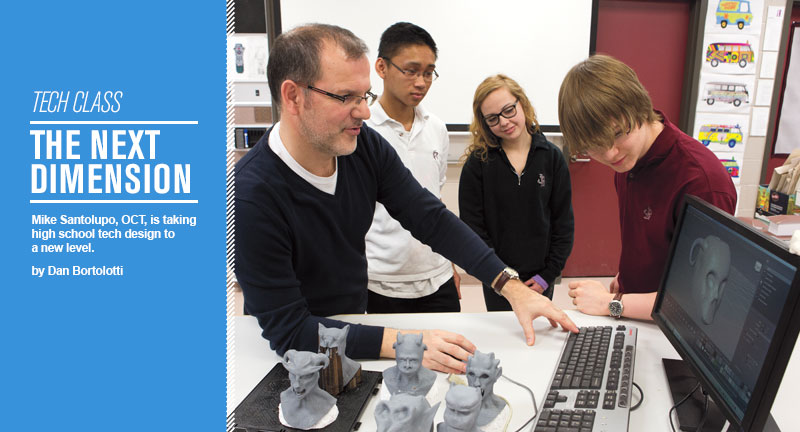
Tech Class
The Next Dimension
by Dan Bortolotti
CHALLENGE Helping students from Grades 10 through 12 develop a passion for architectural and industrial design, graphics and animation.
SOULTION Harness the power of the most sophisticated design software and bring the students’ creations alive in three dimensions. Mike Santolupo, OCT, has students using cutting-edge CAD (computer-assisted design) technology to explore their ideas and then sends the results to a Cimetrix 3-D printer. “Between the software and the 3-D printer, I’ve tried to emulate what you would see in a professional design studio,” he says. “I’m giving these advanced design tools to kids, and we’re getting incredible results.”
LESSONS LEARNED Santolupo’s Grade 10 students begin by using AutoCAD (autodesk.ca) to design a TV remote. “They start by making pencil sketches, and then they use AutoCAD to draw first in 2-D, and then 3-D. We can send the file to the 3-D printer so they can hold a full-scale model in their hands and make a good assessment of the ergonomics.”
In Grade 11, students create a concept car using Alias (autodesk.com/alias). “Every professional automotive company uses Alias for their design work, but we are the only high school that uses it,” says Santolupo, a former engineer with General Motors. “Even some universities won’t use it because they claim it’s too hard.”
By Grade 12, the students are creating aliens and other original creatures with Mudbox (autodesk.com/mudbox ), a program for animators and video game designers. Their final project involves creating an entire chess set, designing each of the different pieces, which are then output by the 3-D printer. “The ideas the kids have about chess sets are much different from the traditional ideas,” Santolupo says. One of his recent students made all the pieces spherical. “He also took manufacturing, so he made the chessboard in that class: each of the squares had carved-out half-spheres so the pieces fit in there like a bowl. So this was a great cross-curricular activity, too.”
OBSERVATIONS The sophisticated software and hardware allow students to express ideas that might otherwise have been trapped in their imaginations. It levels the playing field for creative kids who may lack the ability to draw or sculpt a model. “Had these kids not had access to a 3-D printer, I just don’t think their ideas would’ve come out that way. Now they don’t have to have incredible artistic skills. If I had asked these kids to physically make chess pieces, I don’t even know what kind of material I would have given them.”
Santolupo says he’s no longer surprised at how easily the students get comfortable with technology. “I do my best to get the latest releases, so we are using software that is the same as what professionals use. And the students are more than capable: they can use this software far more effectively than you might expect.”
YOU CAN DO IT TOO!
You’ll need
- up-to-date computers, design software and a 3-D printer
Steps
- Visit the Autodesk Education Community (students.autodesk.com) to see if your school qualifies for free versions of some design software.
- Start with the simplest programs and encourage students to experiment with the more advanced features.
- Explore the possibility of acquiring a 3-D printer: Cimetrix products start around $10,000, but they can also be rented. (Santolupo’s was donated.) Less expensive models are also available.
Helpful Hints
Mike Santolupo recommends teachers share ideas and resources: “I work with several teachers in Ontario, as well as some in the States. It’s about finding other schools and teachers who have the same passion.”